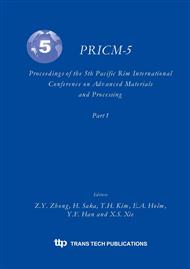p.1113
p.1117
p.1121
p.1125
p.1129
p.1133
p.1137
p.1141
p.1145
A Study on Nanometer-Sized BaTiO3-Based Dielectric for Ni-MLCC with Y5V Specification
Abstract:
In order to meet the demand on the miniaturization and manufacturing cost reduction of the multilayer ceramic capacitors we have developed a nano-BaTiO3-based non-reducible dielectric material through a soft chemical route. The particle size has been decreased down to the level of 30nm and the dielectric medium could be co-fired with Ni-electrodes under a N2+H2 reducing atmosphere. X-ray diffraction, scanning electron microscopy, transmission electron microscopy, and volume shrinkage have been employed to detect the sintering behavior and microstructure evolution including grain growth, pore formation and body densification. Dielectric measurements showed, after a sintering process at 1200°C for 2h, the dielectric constant was 8800, the dissipation factor was less than 2%, the insulation resistance was about 12~13exp Ω.cm, and the temperature coefficients of capacitance were less than 22% and -82% at -30°C and 85°C respectively. On the basis of the results it is anticipated that the material could be used for the Ni-MLCC with thin dielectric layers with a Y5V specification in the Electron Industries Association standard.
Info:
Periodical:
Pages:
1129-1132
Citation:
Online since:
January 2005
Authors:
Keywords:
Price:
Сopyright:
© 2005 Trans Tech Publications Ltd. All Rights Reserved
Share:
Citation:


